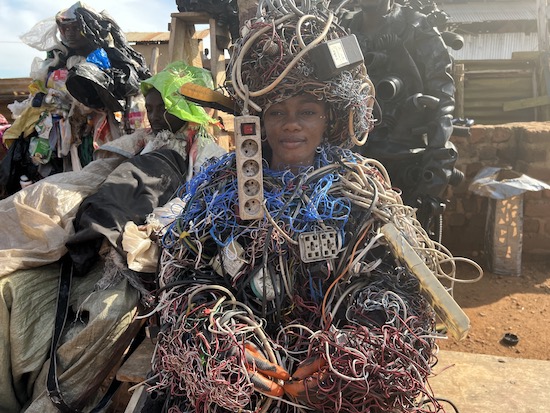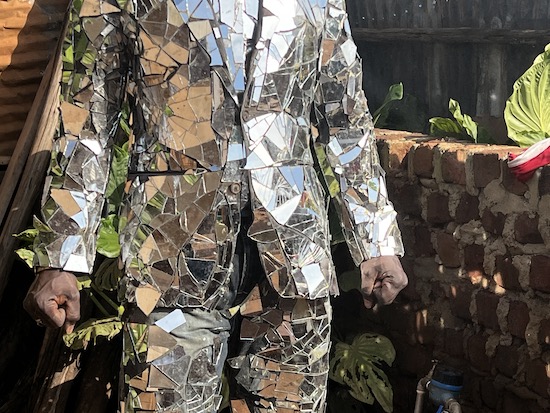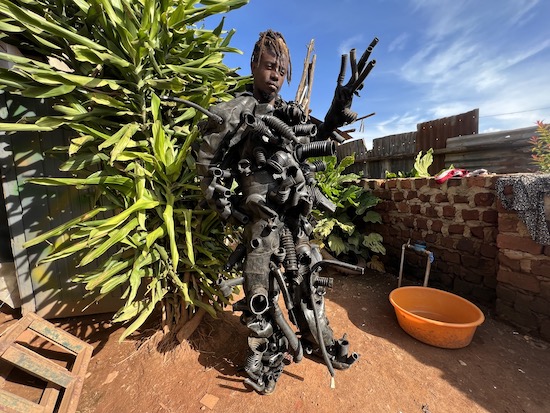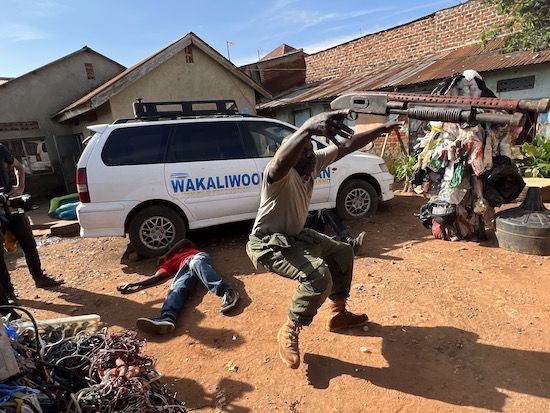Frowning under a blinding midday sun, with his camera held like a weapon, Isaac Nabwana yells “Action,” demanding that chaos be unleashed. Three men in military fatigues scream in panic at each other, to then turn their ire on monsters made from the plastic refuse normally found strewn on waste ground. Pistols and shotguns are drawn, but their bodies are repelled by strange forces; flying backwards, the three men crumple into a heap. Their boots at exaggerated angles, slump down into the Ugandan earth, finally coming to rest in clouds of orange dust. “Cut,” Issac screams with a broad grin and the whole crew bursts into laughter and applause. As percussion rings out, it feels more like a party than a film set.
I have just walked into the home of Ramon Studios, otherwise known as Wakaliwood – Uganda’s most ambitious movie makers. For over ten years, their feature films of Kung Fu fighting, hilarious special effects and noisy explosions have created a cult-like following across Uganda. The 2010 movie Who Killed Captain Alex?, now viewed nearly 8 million times on YouTube, reached an international audience and changed everything for Isaac and his wife Miriam, who acts as the studio manager of their one floor compound in the slum village of Wakaliga, Kampala. They shoot where they live.
The audacious passion and single-mindedness that Wakaliwood is built upon has taken Isaac’s films out of the slums and across the globe to inspire other filmmakers to follow suit. Last summer took their project one step further, when they were invited to the Documenta Art Festival in Germany to screen their new movie Football Kommando. Isaac is very clear on how he believes films should be made. “We are only here on earth for a short period of time,” he says. “You cannot wait for budget or worry if it’s too sunny or raining – use what you have, because that’s life. This day will never come back”.
It is raw filmmaking as a family, more mission than movie. Like the early days of Hollywood, it is shooting on the fly, building props from welding scrap and trusting a joyous process as it evolves before you. “I write only 40 percent of the movie and the rest is what happens on set,” Isaac says. “If something is missing, the audience will never know – and anyway we have the VJs to take care of that.” Wakaliwood films are shot mostly in Luganda language with English subtitles, but are also accompanied by a VJ or Video Jockey. A concept that originates from village screening halls, where equipped with a microphone VJs offer live commentary: noisily making jokes, guiding the audience through the plot or even giving their opinion to whether what they are watching is any good or not.
Today, a short film is being shot with the Toyé co-operative from Kinshasa in the Democratic Republic of Congo, a group of multidisciplinary artists currently travelling across East Africa wearing extravagant costumes made from plastic waste found in dumps or on the street. It is conceptual avant-garde style, worn as protest.

I sit with Patrick Nikete and Eddy Ekete between takes. Patrick is wearing a suit made from broken mirrors, as he glows all refracted light and smiles. He allows Eddy to lean back and explain: “We met the Wakaliwood team at Nyege Nyege festival [Uganda’s bewildering orgy of underground electronic dance music from across the region] and it made sense to work together. Our principles and hopes must be transformed by others Africa-wide. We need one vision against plastic waste – but don’t get me wrong, we love Kung Fu too."
In a world where plastic dominates our lives, Toyé (meaning “we have arrived”) decry that the pollutants blighting their continent and that heat up our planet are predominantly Western and Chinese. Theirs is a desire to turn the clock back: “In Africa, we create biodegradable waste: peels and skins. Even before we understood pollution we made compost this way to make the land more fertile – it’s not a new idea. Recycling for westerners is just dumping your problem on others. There is nothing magical going on once it is out of sight.” The irony that they can sell their costumes made from detritus to wealthy art collectors is not lost on them either. “It’s an opportunity for us to ship some of it back,” Eddy laughs.
Patrick (or ‘Homme Mirroir’) explains, “That our ancestors sold the earth beneath our feet is down to vanity. As kings at their most ornate, they were yet to see their own reflection but come the 1300s or 1400s, Europeans held up mirrors to them and it warped their minds.”

Another action scene is being set up and the crew start calling for Spiritus, who Isaac has decided will represent nature and stand as a God amongst us. Everyone chants out “Jajjah Nyege!” as this lithe Congolese artist maniacally rings his hand bell, never breaking character; electric energy flowing through his limbs. Covered in earth and paint, he is practically naked. At crotch-level stands an upright carrot-shaped phallus. Desperately clutching a statuette to his chest, as if absorbing its power, he faces up to fight an evil muzungu (a white man) controlling a robot made from a thousand leads and broken pieces of electric circuit boards. There can only be one victor. “I am here to shake up people’s consciousness, Spiritus tells me later on. “People are too busy partying and sleepwalking through life so when I wear this between my legs it’s not just to draw attention from women, it’s for everyone. I’m not here to be subtle.”
It is certainly not an accusation one could level at Wakaliwood either.
As a teen in the ‘80s, Isaac clearly recalls the violence and upheaval of Uganda’s civil war but also the explosion of Hollywood onto the big screens. “I wouldn’t go to the cinema halls,” Isaac tells me with a rigid pride. “It was more about imagination. My friends would come back and re-enact what they had seen. This was a forest of eucalyptus trees back then. We would flip somersaults all day – that’s how I learned about Bruce Lee.”
Isaac insists that the story they are telling today is a neo-colonial one, from a country where people are astounded by the rapid advancement of Chinese-sponsored concrete infrastructure being built all around them. “There are always new stories, but this week we hear that gold and oil are being extracted. This is what the Gods are fighting for. For justice. Anyone watching the film will understand.”
As we become saturated with the golden light of late afternoon Isaac screams, “It’s a wrap!”. Harriet, who has been buzzing across the set all day is beaming. She will now make sure that everyone is fed. The Toyé crew leave to lead a procession through the village. The bedlam from the set now made real in Wakaliga is where these two creative entities meet. It is impossible to tell if CocoMan, dressed in rough bark and bounding like a gorilla, is hero or villain as the children of the village cautiously approach in awe and then run for their lives, splashing through puddles and screaming as he springs and jerks in their direction. Patrick, as the mirror man stops to pose as he struts a louche walk – a twisted take on the Congolese Sapeur. Eyes all around are as wide as they are fixed.
The parade continues past goats and ducks that run loose in offence, past canals of thick human waste and young men lounging horizontally on motorbikes. Aliens may as well have landed here today. On the roof of a neon-lit shack with Bar California scrawled on its iron doors, a large black bird with a horribly pointed beak joins in with a maddening commentary of long angry squawks.
Something different has happened, and it has charged the molecules enough to electrify a whole village. Posters for politicians, pasted up on corrugated iron, peel at the edges, ignored. Cakes, wrapped in plastic with names piped upon them, remain uneaten. Footballs on waste ground, for the moment, lie un-kicked. “It is beautiful to be here, engaging with people,” Patrick tells me, propped up on his cane – a one-man beacon of hope.

“One of us lay down on the street back home in Kinshasa recently and people thought it was a pile of garbage ready to be burned. That’s what happens to trash in neighbourhoods like this. We ran over, screaming ‘NO! NO! there’s a man in there!’ and saved his life. A mob formed to see what was happening and then a woman screamed ‘LET’S BURN HIM ANYWAY!’” Patrick is laughing now but struggles to shrug off the terrifying world that he battles to survive in. As he pimp-walks away into the sun, the scary bird on the roof never lets up with its incessant taunting.


